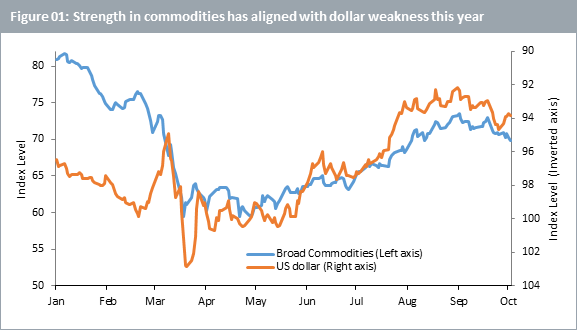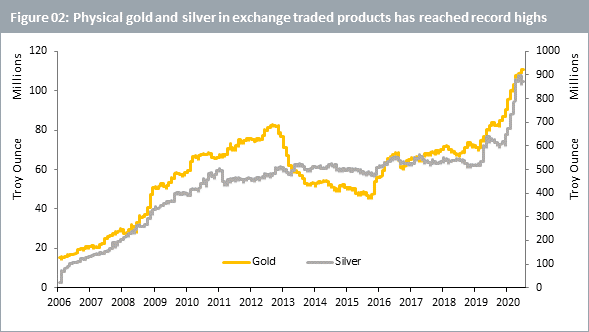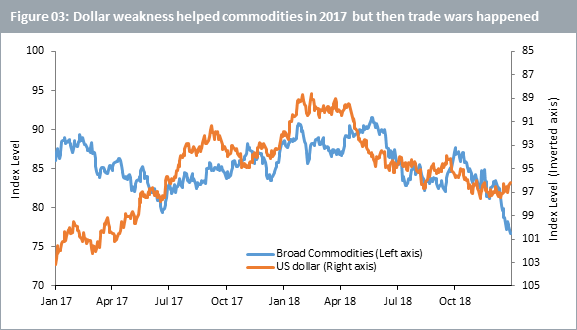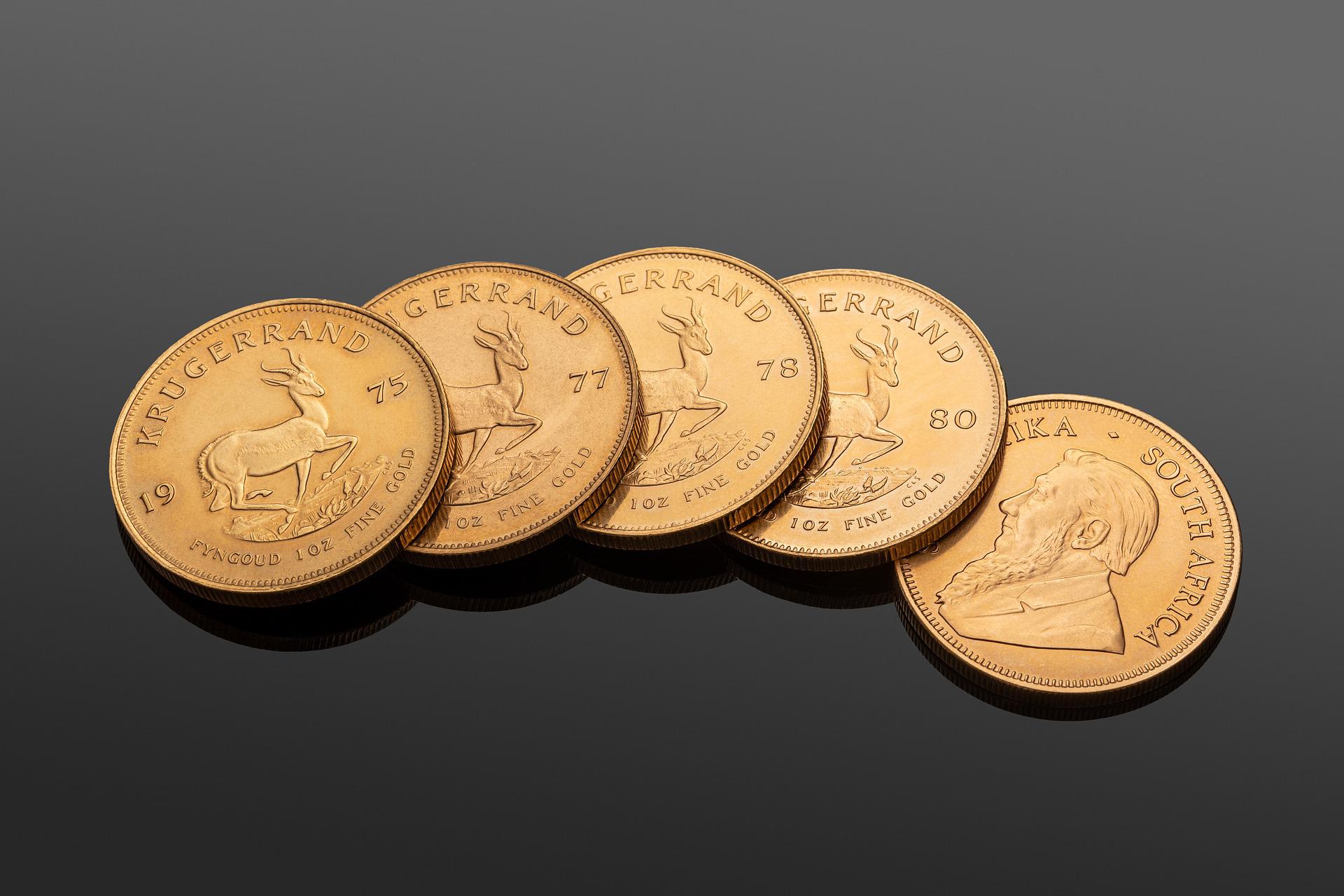Analys
A moment in markets – Dollar weakness bodes well for commodities


The US dollar has been meaningfully weak this year with most of the depreciation occurring since June. The dollar index spot rate – measured as the average exchange rate between the dollar and major world currencies – fell by over 8% between 15 May and 31 August (see figure 01 below). The US dollar is typically seen as a safe-haven asset during times of financial market volatility and economic uncertainty. This year, however, it has failed to live up to that reputation.
In March, when the pandemic first tightened its grip on markets, the dollar rose sharply but was unable to sustain its gains for long. In September again, as second wave fears and US election uncertainty paired up to create volatility in stock markets, dollar initiated a rebound. It appears to have lost steam even more quickly this time around though.

Weaker for longer?
What else can dollar bulls count on if haven demand fails to materialize despite the challenges facing markets and the economy? Currency strength is relative and weakness in other major currencies including sterling and euro could help revive the dollar. Euro and sterling may fall if Brexit uncertainty and disruption hurt the economic prospects for both Europe and the UK. This would need to be supplemented by continuously improving economic data in the US.
Dollar bears would point to short-term risks facing the economic recovery including second wave virus risks as well as election uncertainty. If the conversation veers towards longer term prospects, they may end up throwing a knockout punch by highlighting the Federal Reserve’s lower for longer policy. In the end, ultra-loose monetary policy for a protracted period is bound to put pressure on the currency.

Commodity investors aren’t complaining
Dollar weakness has helped fuel the recovery rally in broad commodities – albeit supporting different commodity sectors in different ways and to varying degrees. There are two key reasons why dollar weakness supported commodities – notably since June – and why continued weakness in the greenback could be good news for commodity investors:
- The haven effect: With the dollar being weak, investors have turned to alternative safe havens as better ‘stores of wealth’. Gold and silver have benefitted the most from this ‘haven effect’. Dollar’s strength and gold’s weakness were both short-lived in March. Investors have turned to physical precious metals knowing that, with their finite supply, they cannot be devalued like fiat currencies by policymakers in response to crises (see figure 02 above).
- The purchasing power effect: Cyclical commodities also benefit from dollar weakness as holders of other currencies find it cheaper to buy dollar-denominated commodities. Both industrial metals and agricultural commodities stand to benefit from this effect.

There is, however, a catch…Trade wars
The dollar depreciated considerably in 2017 and start of 2018 which lent support to broad commodities (see figure 03 above). Arguably, among the reasons for the erosion in the currency’s value was an increase in protectionist rhetoric from President Trump. The possibility of the US isolating itself rather than being an integral force in the global economic machine hurt the dollar back then. The reason why commodities could not sustain a lasting rally was because the protectionist rhetoric eventually culminated in a trade dispute between the US and China with tariffs directly imposed on several commodities. While gold benefitted as a geopolitical hedge, cyclical commodities including industrial metals and agriculturals suffered. The catch, therefore, is that for broad commodities to make lasting gains from a weak dollar, the weakness in the currency must stem from accommodative monetary policy rather than an acceleration in trade wars. If trade tensions escalate again, defensive commodities like precious metals will be expected to extend their gains over cyclical sectors.
Mobeen Tahir, Associate Director, Research, WisdomTree
Analys
Breaking some eggs in US shale

Lower as OPEC+ keeps fast-tracking redeployment of previous cuts. Brent closed down 1.3% yesterday to USD 68.76/b on the back of the news over the weekend that OPEC+ (V8) lifted its quota by 547 kb/d for September. Intraday it traded to a low of USD 68.0/b but then pushed higher as Trump threatened to slap sanctions on India if it continues to buy loads of Russian oil. An effort by Donald Trump to force Putin to a truce in Ukraine. This morning it is trading down 0.6% at USD 68.3/b which is just USD 1.3/b below its July average.

Only US shale can hand back the market share which OPEC+ is after. The overall picture in the oil market today and the coming 18 months is that OPEC+ is in the process of taking back market share which it lost over the past years in exchange for higher prices. There is only one source of oil supply which has sufficient reactivity and that is US shale. Average liquids production in the US is set to average 23.1 mb/d in 2025 which is up a whooping 3.4 mb/d since 2021 while it is only up 280 kb/d versus 2024.
Taking back market share is usually a messy business involving a deep trough in prices and significant economic pain for the involved parties. The original plan of OPEC+ (V8) was to tip-toe the 2.2 mb/d cuts gradually back into the market over the course to December 2026. Hoping that robust demand growth and slower non-OPEC+ supply growth would make room for the re-deployment without pushing oil prices down too much.
From tip-toing to fast-tracking. Though still not full aggression. US trade war, weaker global growth outlook and Trump insisting on a lower oil price, and persistent robust non-OPEC+ supply growth changed their minds. Now it is much more fast-track with the re-deployment of the 2.2 mb/d done already by September this year. Though with some adjustments. Lifting quotas is not immediately the same as lifting production as Russia and Iraq first have to pay down their production debt. The OPEC+ organization is also holding the door open for production cuts if need be. And the group is not blasting the market with oil. So far it has all been very orderly with limited impact on prices. Despite the fast-tracking.
The overall process is nonetheless still to take back market share. And that won’t be without pain. The good news for OPEC+ is of course that US shale now is cooling down when WTI is south of USD 65/b rather than heating up when WTI is north of USD 45/b as was the case before.
OPEC+ will have to break some eggs in the US shale oil patches to take back lost market share. The process is already in play. Global oil inventories have been building and they will build more and the oil price will be pushed lower.
A Brent average of USD 60/b in 2026 implies a low of the year of USD 45-47.5/b. Assume that an average Brent crude oil price of USD 60/b and an average WTI price of USD 57.5/b in 2026 is sufficient to drive US oil rig count down by another 100 rigs and US crude production down by 1.5 mb/d from Dec-25 to Dec-26. A Brent crude average of USD 60/b sounds like a nice price. Do remember though that over the course of a year Brent crude fluctuates +/- USD 10-15/b around the average. So if USD 60/b is the average price, then the low of the year is in the mid to the high USD 40ies/b.
US shale oil producers are likely bracing themselves for what’s in store. US shale oil producers are aware of what is in store. They can see that inventories are rising and they have been cutting rigs and drilling activity since mid-April. But significantly more is needed over the coming 18 months or so. The faster they cut the better off they will be. Cutting 5 drilling rigs per week to the end of the year, an additional total of 100 rigs, will likely drive US crude oil production down by 1.5 mb/d from Dec-25 to Dec-26 and come a long way of handing back the market share OPEC+ is after.
Analys
More from OPEC+ means US shale has to gradually back off further

The OPEC+ subgroup V8 this weekend decided to fully unwind their voluntary cut of 2.2 mb/d. The September quota hike was set at 547 kb/d thereby unwinding the full 2.2 mb/d. This still leaves another layer of voluntary cuts of 1.6 mb/d which is likely to be unwind at some point.

Higher quotas however do not immediately translate to equally higher production. This because Russia and Iraq have ”production debts” of cumulative over-production which they need to pay back by holding production below the agreed quotas. I.e. they cannot (should not) lift production before Jan (Russia) and March (Iraq) next year.
Argus estimates that global oil stocks have increased by 180 mb so far this year but with large skews. Strong build in Asia while Europe and the US still have low inventories. US Gulf stocks are at the lowest level in 35 years. This strong skew is likely due to political sanctions towards Russian and Iranian oil exports and the shadow fleet used to export their oil. These sanctions naturally drive their oil exports to Asia and non-OECD countries. That is where the surplus over the past half year has been going and where inventories have been building. An area which has a much more opaque oil market. Relatively low visibility with respect to oil inventories and thus weaker price signals from inventory dynamics there.
This has helped shield Brent and WTI crude oil price benchmarks to some degree from the running, global surplus over the past half year. Brent crude averaged USD 73/b in December 2024 and at current USD 69.7/b it is not all that much lower today despite an estimated global stock build of 180 mb since the end of last year and a highly anticipated equally large stock build for the rest of the year.
What helps to blur the message from OPEC+ in its current process of unwinding cuts and taking back market share, is that, while lifting quotas, it is at the same time also quite explicit that this is not a one way street. That it may turn around make new cuts if need be.
This is very different from its previous efforts to take back market share from US shale oil producers. In its previous efforts it typically tried to shock US shale oil producers out of the market. But they came back very, very quickly.
When OPEC+ now is taking back market share from US shale oil it is more like it is exerting a continuous, gradually increasing pressure towards US shale oil rather than trying to shock it out of the market which it tried before. OPEC+ is now forcing US shale oil producers to gradually back off. US oil drilling rig count is down from 480 in Q1-25 to now 410 last week and it is typically falling by some 4-5 rigs per week currently. This has happened at an average WTI price of about USD 65/b. This is very different from earlier when US shale oil activity exploded when WTI went north of USD 45/b. This helps to give OPEC+ a lot of confidence.
Global oil inventories are set to rise further in H2-25 and crude oil prices will likely be forced lower though the global skew in terms of where inventories are building is muddying the picture. US shale oil activity will likely decline further in H2-25 as well with rig count down maybe another 100 rigs. Thus making room for more oil from OPEC+.
Analys
Tightening fundamentals – bullish inventories from DOE

The latest weekly report from the US DOE showed a substantial drawdown across key petroleum categories, adding more upside potential to the fundamental picture.

Commercial crude inventories (excl. SPR) fell by 5.8 million barrels, bringing total inventories down to 415.1 million barrels. Now sitting 11% below the five-year seasonal norm and placed in the lowest 2015-2022 range (see picture below).
Product inventories also tightened further last week. Gasoline inventories declined by 2.1 million barrels, with reductions seen in both finished gasoline and blending components. Current gasoline levels are about 3% below the five-year average for this time of year.
Among products, the most notable move came in diesel, where inventories dropped by almost 4.1 million barrels, deepening the deficit to around 20% below seasonal norms – continuing to underscore the persistent supply tightness in diesel markets.
The only area of inventory growth was in propane/propylene, which posted a significant 5.1-million-barrel build and now stands 9% above the five-year average.
Total commercial petroleum inventories (crude plus refined products) declined by 4.2 million barrels on the week, reinforcing the overall tightening of US crude and products.


-

 Nyheter3 veckor sedan
Nyheter3 veckor sedanUSA inför 93,5 % tull på kinesisk grafit
-

 Nyheter3 veckor sedan
Nyheter3 veckor sedanFusionsföretag visar hur guld kan produceras av kvicksilver i stor skala – alkemidrömmen ska bli verklighet
-

 Nyheter3 veckor sedan
Nyheter3 veckor sedanWestinghouse planerar tio nya stora kärnreaktorer i USA – byggstart senast 2030
-

 Nyheter3 veckor sedan
Nyheter3 veckor sedanRyska militären har skjutit ihjäl minst 11 guldletare vid sin gruva i Centralafrikanska republiken
-

 Nyheter4 veckor sedan
Nyheter4 veckor sedanEurobattery Minerals förvärvar majoritet i spansk volframgruva
-

 Nyheter1 vecka sedan
Nyheter1 vecka sedanKopparpriset i fritt fall i USA efter att tullregler presenterats
-

 Nyheter1 vecka sedan
Nyheter1 vecka sedanLundin Gold rapporterar enastående borrresultat vid Fruta del Norte
-

 Nyheter3 veckor sedan
Nyheter3 veckor sedanKina skärper kontrollen av sällsynta jordartsmetaller, vill stoppa olaglig export









